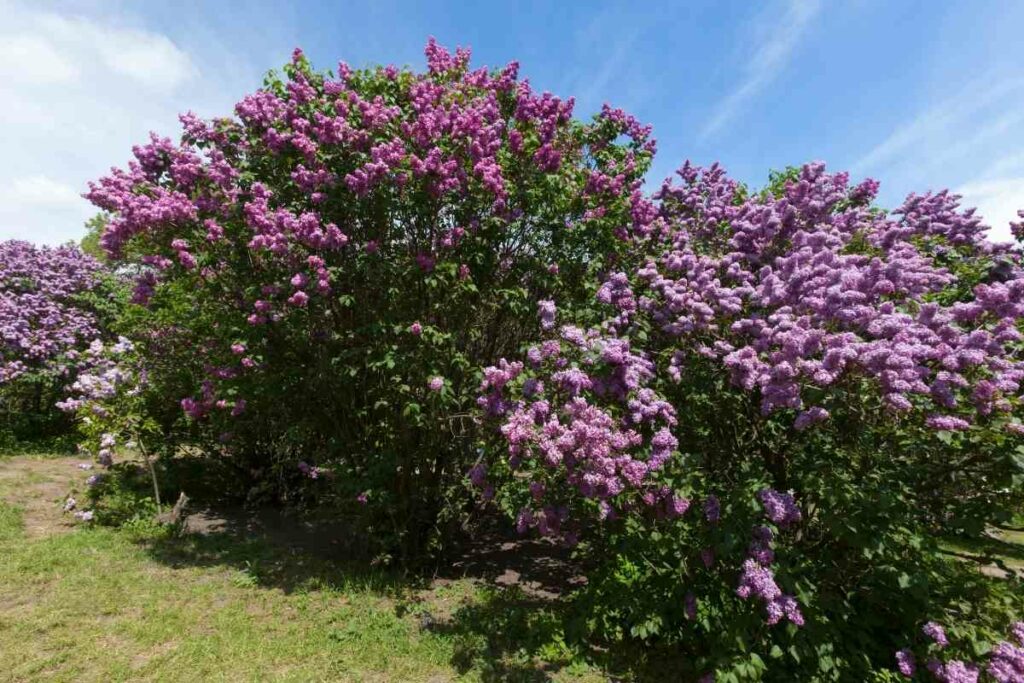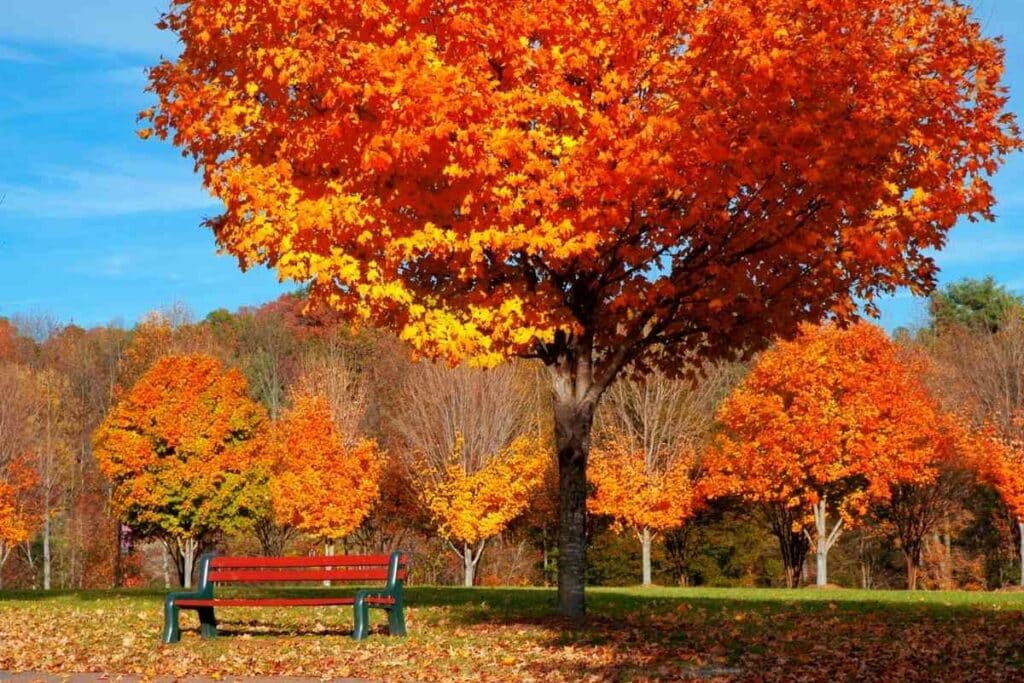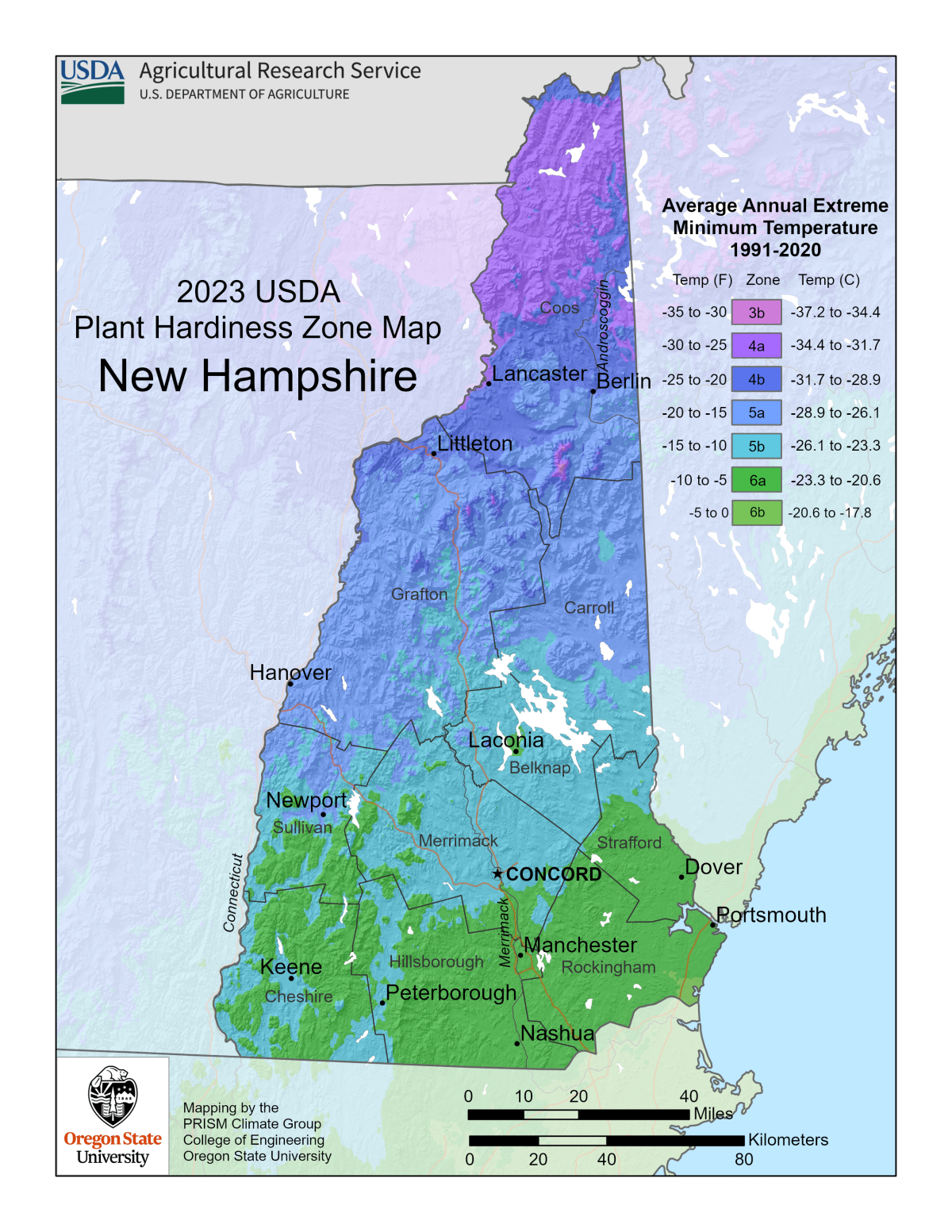New Hampshire Plant Hardiness Zones
| USDA Hardiness Zone | Average Minimum Extreme Winter Temperature Range Fahrenheit (°F) Celsius (°C) | Average Last Frost Date Range In Spring (Beginning Of The Growing Season) | Average First Frost Date Range In Autumn (End Of The Growing Season) |
|---|---|---|---|
| 3b | -35°F to -30°F -37.2°C to -34.4°C | Mid to late May | Mid to late September |
| 4a | -30°F to -25°F -34.4°C to -31.7°C | Mid to late May | Mid to late September |
| 4b | -25°F to -20°F-31.7°C to -28.9°C | Mid to late May | Mid to late September |
| 5a | -20°F to -15°F-28.9°C to -26.1°C | Early to mid-May | Late September to early October |
| 5b | -15°F to -10°F -26.1°C to – 23.3°C | Early to mid-May | Late September to early October |
| 6a | -10°F to -5°F -23.3°C to 20.6°C | Late April to early May | Early to mid-October |
| 6b | -5°F to 0°F -20.6°C to 17.8°C | Late April to early May | Mid to late October |
New Hampshire Growing Conditions

Credit to Wikipedia
General Climate
New Hampshire’s hardiness zones range from 3b to 6b. It has a humid continental climate, with a small area of subarctic climate in the highlands.
Humid continental climates experience four distinct seasons. It has warm summers with higher humidity and winters that are long and cold with lots of snow. Precipitation is evenly distributed throughout the year. Southern New Hampshire has hot summers, while the rest of the state experiences warm summers.
Proximity to the Atlantic ocean means that coastal New Hampshire sees less extreme temperatures. This is because large bodies of water absorb heat in the hot months and lose heat in the cold months. This moderates the seasonal temperatures of the surrounding areas.
The interior of the state experiences hot and cold air masses from the rest of the continent. This creates variable weather patterns, such as storms and blizzards.
The state can even feel effects from cyclones coming in from the south Atlantic. These events lead to flooding, high winds and can cause damage to your garden and property.
Microclimates
USDA plant hardiness zones are an important starting point for your garden, but you’ll also need to consider microclimates.
Microclimates are areas where specific conditions create a climate different from the climate they’re situated in.
Buildings, fences, paved areas, or short hills and valleys can create these microclimates.
They can be as small as a space in your backyard or as large as a city.
In other words, learn about your local conditions from local experts to see if your garden falls into a microclimate.
Extreme Weather
Coastal Storms
Coastal storms are a common occurrence when living on the eastern shore of New Hampshire. These storms, also known as Nor’easters, are damaging to your property. The storms cause flooding as well as coastal erosion.
Choose plants that tolerate wet conditions, saline conditions, and have strong root systems. These plants help combat coastal erosion, displace water flow, and build a strong resilient garden. Suggested plants include:
- Cordgrass
- Swamp mallow
- Marsh elder
Cold Waves
A cold wave is a quick drop in temperature within a short period of time (24 hours). These extreme weather events are also known as deep freezes or cold snaps. They occur when very cold air moves in from northern arctic regions.
Cold temperatures and lots of snow are common in New Hampshire’s long winters. However, the sudden cold waves can have destructive effects on the garden.
Plant cover crops as a form of “living mulch” as they protect other plants from cold frosts. They also build soil and protect against erosion and displacement during heavy rains, snow, and melts.
During a deep freeze, these cover crops may die but they become mulch which helps to sustain plants through the winter.
Winter Rye is a great cover crop that withstands cold temperatures.
Growing Season
On average, New Hampshire has 135 frost-free growing days. First frosts occur as early as September to as late as October, while last frosts can occur anywhere from late April to late May.
Because New Hampshire has a cool growing climate, cold-tolerant plants are best for gardening success.
Veggies like lettuce, kale & radishes do well in cooler climates. They have a short period of growth and can be succession planted multiple times throughout the season.
New Hampshire Gardening Tips

Start Veggies Indoors
With a shorter growing season, many gardeners start their seeds indoors. This helps to protect more delicate veggies and flowers from late and unexpected frosts.
Growing seeds indoors can be as easy as placing seed trays in a bright window in your kitchen.
Another method (with higher success rates) is to set up shelves with grow lights and heat mats. This provides the best chance of survival for seedlings.
Grow lights also remove the chance of seedlings becoming “leggy”. This is when the plants grow tall to reach for the sunlight. It causes the plants to grow weak stems which eventually break.
Planting With Acidic Soils
Acidic soil (also called spodosols) makes up the majority of New Hampshire’s soil profile. Adding compost helps build more neutral soils. Another option is to plant varieties of shrubs, flowers and herbs that benefit from acidic soil. It is a fun way to work with the native soil rather than against it.
My favorite companion planting group actually favors acidic soils. This mix involves fruiting shrubs, perennial and annual herbs, beneficial pollinator plants, and loads of veggies!
Not only do these plants benefit from this soil type but they work together to create a stronger and healthier environment. In doing so, they are more productive and have higher yields.
Follow these suggestions for acidic companion planting:
- Start by planting lilacs at the back of the garden bed
- The flowers are edible
- They attract beneficial pollinators
- Azaleas and Rhododendrons are also good options to add to the back border
- Next, plant a group of blueberries in front of the lilacs
- A minimum of 5 blueberries is a great start
- You can enjoy harvesting your own fruit
- Use thyme as a ground cover and let it spread throughout the garden bed
- Ground covers help retain moisture
- Thyme is a beneficial herb that you can enjoy fresh or dried
- Plant annual basil. This adds fragrance and gives height between the thyme and the blueberries
- It is an edible herb
- It also attracts a lot of pollinators
- Veggies to add to this garden bed are:
- Sweet potatoes
- Parsley
- Broccoli
So, try planting acidic-tolerant plants for a beneficial garden that not only feeds your family, but builds soil, and helps pollinators thrive.
Consult With Local Professionals
Consulting with local gardening professionals allows you to benefit from their experience with your area’s conditions, the plants that do well there, and overall best practices.
New Hampshire Plant Suggestions

Trees
- Red Oak (Quercus-rubra)
- Paper Birch (Betula papyrifia)
- Sugar Maple (Acer saccharum)
Shrubs
- Mountain Laurel (Kalmia latifolia)
- New Jersey Tea (Ceanothus americanus)
- Smooth Alder (Alnus serrulata)
Flowers
- Butterfly Weed (Asclepias tuberosa)
- Indian Hemp (Apocynum cannabinum)
- Dragons Mouth (Arethusa bulbosa)
Vegetables
- American Groundnut (Apios americana)
- Arugula (Eruca vesicaria)
- Potato (Solanum tuberosum)
Herbs
- Anise Hyssop (Agastache foeniculum)
- Chives (Allium schoenoprasum)
- Bearberry (Uva ursi)
Spices
- White Sage (Artemisia ludoviciana)
- Canada Wild Ginger (Asarum canadense)
- Fireweed (Chamaenerion angustifolium)
Fruits
- Red Chokeberry (Aronia arbutifolia)
- Black Chokeberry (Aronia melanocarpa)
- Common Hackberry (Celtis occidentalis)
Succulents
- Eastern Prickly Pear (Opuntia humifusa)
- Hen and Chicks (Sempervivum tectorum)
- Goldmoss Stonecrop (Sedum acre)
Disclaimer
Any of the above can change and is not exhaustive.
Treat anything above like a good starter guide. Then use that as a foundation as you consult with local gardeners, professionals, forecasts, guides, and organizations.

